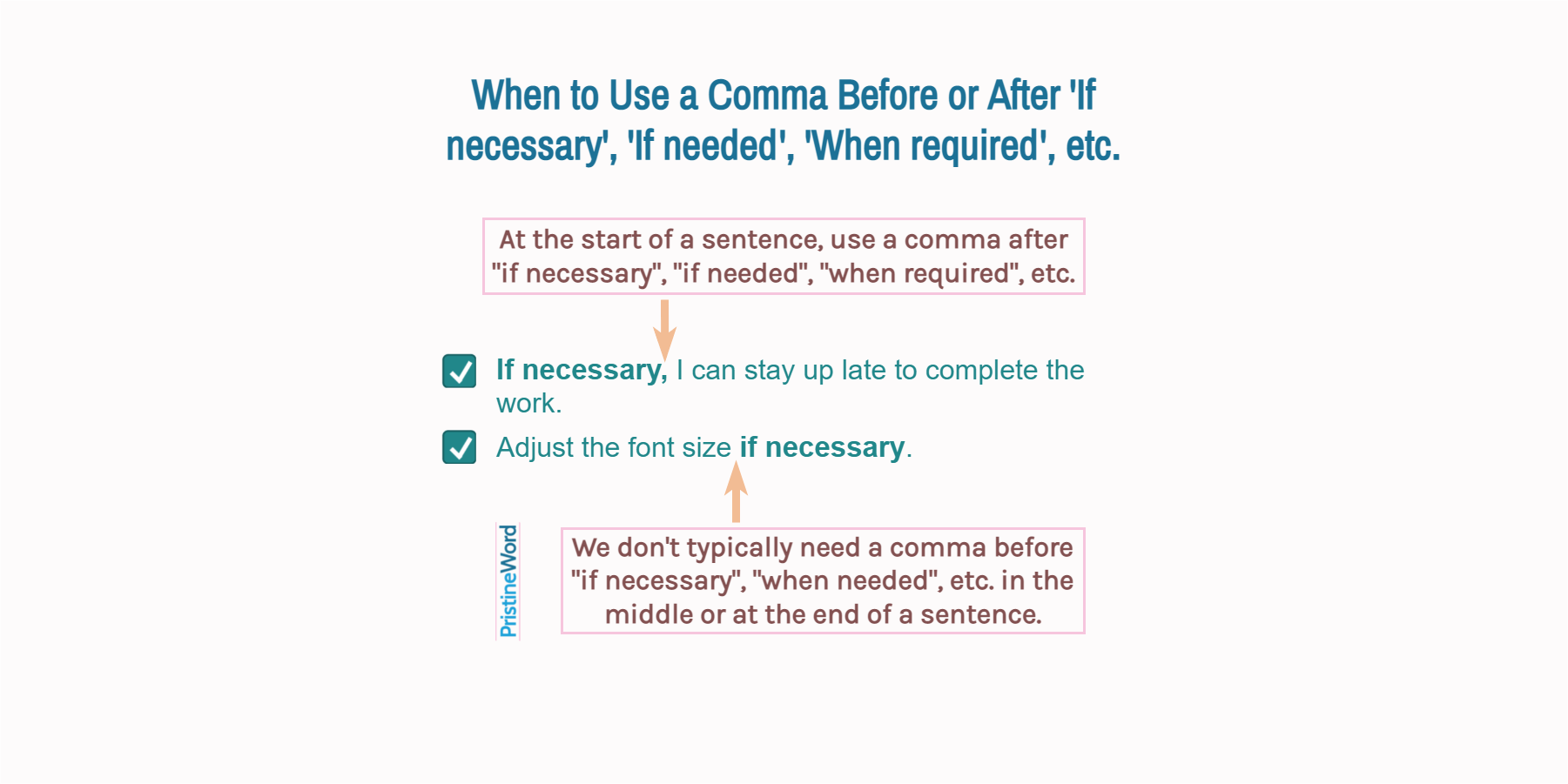At the start of a sentence, use a comma after "if necessary", "if needed", "when required", "where needed", etc. Normally, we don't need a comma before "if necessary", "when needed", etc. in mid-sentence or at the end of the sentence.
At the start of a sentence, use a comma after "if necessary", "if needed", "when required", "where needed", etc.
If necessary, I can stay up late to complete the work.
We don't usually need a comma before "if necessary", "when needed", etc. in the middle or at the end of a sentence.
I will help you if needed.
But use commas to add nonessential information or create a parenthetical feel in the middle or at the end of a sentence.
Use disposable gloves, when required, before handling food.
The British army needs women and men who are willing to fight for their country, if necessary.
Contents
1. 'If necessary', 'If needed', and 'If required' at the Start of a Sentence
"If necessary" means "if it is necessary". Similarly, if you say that something will happen "if needed" or "if required", you mean that it will happen if it is needed or if it is required.
When starting a sentence with the conjunction "if", use a comma to separate the if-clause from the rest of the sentence.
If necessary, you can change the color of your image.
Why to add a comma? As a subordinating conjunction, "if" introduces a dependent clause. When starting a sentence with a dependent clause, we usually place a comma after it.
If needed, funds can be moved from one account to another.
If required, we can provide customers with a truly unique packaging solution.
2. 'If necessary', 'If needed', and 'If required' in Mid-sentence
When an independent clause precedes an if-clause, we do not typically use a comma to separate them.(1)
Adjust the font size if necessary.
The data should be stored and sent if required.
There are situations, however, where the expressions "if necessary", "if needed", or "if required" simply provide extra information; that is, information that can be safely removed without changing the meaning of the sentence.
Use a screwdriver, if necessary, to remove the cover.
You can edit the table of contents, if needed.
Use commas to set off these interrupters or explanatory notes in the middle or at the end of a sentence. (2)
Use a mask, if necessary, to protect yourself from air pollution.
We can provide customers with top class security solutions, if required.
But do not use commas if the expressions "if necessary", "if needed", etc. are important to understand the meaning of the sentence.
The police may use force only if necessary to achieve a legitimate goal.
3. Related Expressions ('When necessary', 'Where needed', etc.)
If you say that something will happen when necessary or where necessary, you mean that it will happen when it is necessary or where it is necessary.
Similarly, you can say:
- when/where needed, or
- when/where required.
Follow the same comma strategy when using when/where in front of "necessary", "needed", or "required". That is, add a comma after the first clause when starting a sentence with a when-clause or a where-clause.
Where necessary, personal protection against mosquito bites must be used.
When needed, they provide an excellent customer service.
We do not usually need a comma if "when necessary", "where required", etc. is preceded by an independent clause.
The officer takes part when necessary.
A consumer protection is assured where needed.
However, place a comma before and after "when necessary", "where necessary", "when required", etc. to introduce a parenthetical expression or interrupt the sentence flow.
The role of new incentives should be consolidated and, where needed, enhanced.
You can use it wherever you want, when needed.
4. More Examples
- All the components have been examined, and renewed when necessary.
- If necessary, we can discuss the different options on Monday.
- You can move it, if necessary, from one place to another.
- I can do it before next week, if needed.
- Yes, further information is available if required.
- Where required, use construction safety helmets.
- If required for a stickier dough, add more water.
- As the legislative branch of the federal government, congress can change laws when needed.
- Use a hammer to release the wheel if necessary.
- When needed, there will be an audit assistant to help us do the work.
- When and where required, you should use personal protective equipment.
5. Conclusion
These simple guidelines will help you decide whether to use a comma when using if/when/where in front of necessary, needed, or required.
- In general, use a comma after "if necessary", "when needed", "if required", etc. to introduce a sentence.
- Do not place a comma before "if necessary", "if needed", "where required", etc. in the middle or at the end of a sentence (unless you are using them as interrupters or explanatory notes).
6. References
(1) Kaufman, Lester; Straus, Jane. The Blue Book of Grammar and Punctuation. Chapter 2 (punctuation).
(2) Strunk JR., William; White, E.B. The Elements of Style. Chapter 1 - Elementary Rules of Usage.

